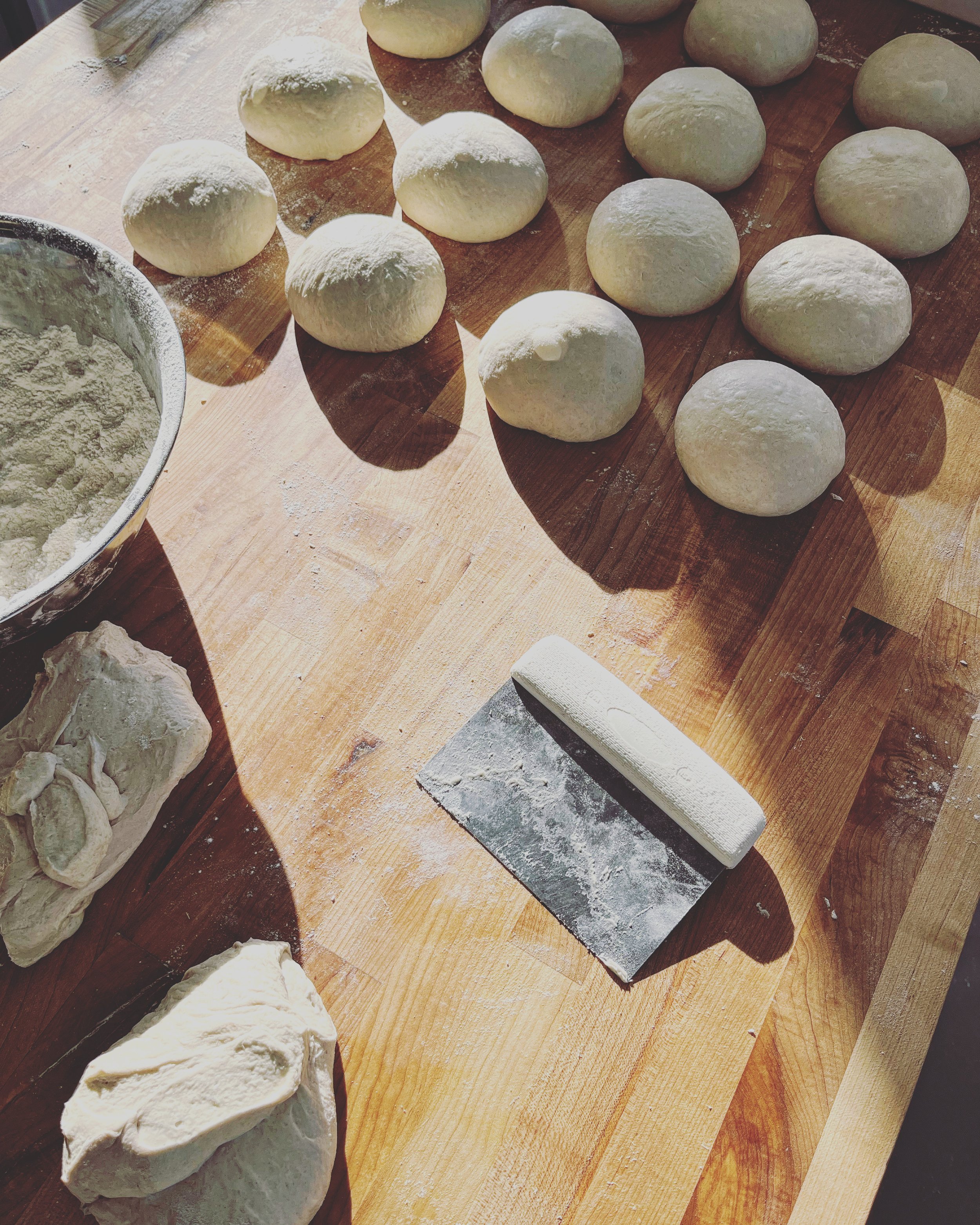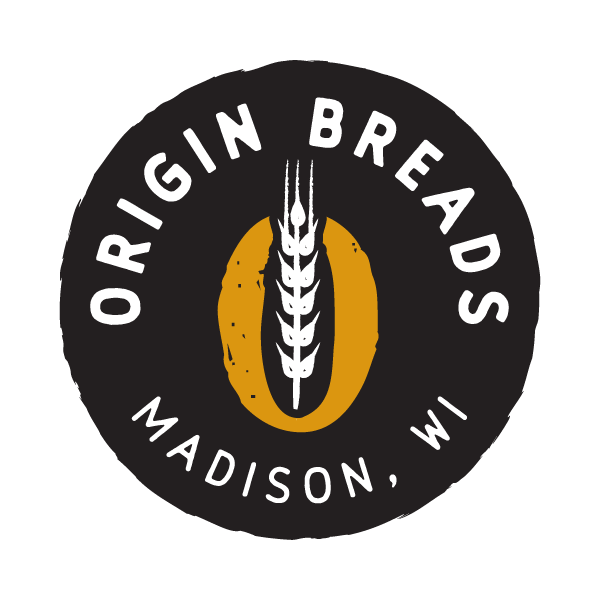
Frequently asked questions.
Who is ORIGIN Breads?
ORIGIN Breads is a small bakery in Madison, WI. Since 2016, owner and baker, Kirk Smock, has been organically building this business, first as a solo project and currently with a small team of bakers. Kirk’s baking obsession began in 2005 while living in Guyana and his fermentation and baking skills were fine-tuned while living in Mozambique.
Why do your products cost more than similar items sold by other bakeries?
Artisanal is a word we shy away from. The actual definition -- a product, especially food or drink, made in a traditional or non-mechanized way -- fits our bread perfectly, but unfortunately it has become another unregulated marketing term that is not always used honestly. But true artisanal products cost more to produce. We hand-mix, shape and bake all of our breads. We believe in supporting our local mill, small farms and fellow local producers and pay more for our ingredients. All of the flours and grains that we use are organic and grown in Wisconsin or in the upper Midwest region. We don't compromise and feel that our breads, pastries, granolas and pizzas are worth the price. For a bit more on the process of making true artisanal bread, have a quick look at this infographic Grist made on "why good bread costs more dough".
What is the best way to store my bread?
Wild yeast is a natural preservative, so with proper storage our breads will stay fresh for about a week. Follow these tips to enjoy our breads at their peak flavor:
Don't store bread in the refrigerator: Unless it's filled with preservatives (and our bread definitely isn't), putting your bread in the fridge will only make it stale faster (for focaccia, see note below).
Cutting your loaf: Slice your loaf in half and cut from the middle of each half. After cutting the number of slices you want, stick the two halves back together. The crust will seal in the crumb and keep your bread fresher longer. If you simply can't resist the end crust (we understand) or are left with half a loaf, loosely wrap the cut end with plastic for storage.
Paper bag vs. plastic bag vs. counter: Paper bags work great for storing bread if you follow the cutting guidelines above. The paper bags that our bread is sold in help keep our crust crisp but the airflow will speed up staling time, so follow the cutting guidelines above. If you don't mind your crust getting a bit softer during storage, wrap your bread loosely and store it in a sealed plastic bag. (Note that you can re-crisp your crust by using a toaster or oven). If you don't have animals or pests to worry about, you can also place the bread cut-side down on a wooden cutting board and store it on your counter for up to four days.
Freezing bread: All of our breads freeze well. You can pre-slice our bread and bagels (very convenient if using for toast, as there is no need to defrost before using), cut the loaf into wedges, or freeze whole. Simply wrap your bread in plastic or foil and then store in a freezer safe plastic bag.
Reheating bread: If you want to reheat a full loaf, put it in an oven preheated to 400 degrees for 8-12 minutes. If you're reheating a partial loaf and don't want the exposed crumb to get toasted, wrap the end in foil before heating. If you're reheating frozen bread, it's best to let it thaw on the counter before reheating as directed above. If you're pressed for time, wrap the loaf in foil before reheating and remove the foil for a few minutes at the end to crisp the crust. If you are using frozen slices, there is no need to defrost before putting them in a toaster. Our PSA: All of our bread also makes excellent toast, which we'd like to remind you is no longer just a breakfast food.
Special instructions for our focaccia: Because our focaccia is also made with wild yeast, it enjoys the same keeping properties as our other breads. But because our focaccia is often topped with cheese and other deliciousness, if you don't manage to eat it all in one day (unlikely, we know), you should store the remaining bread in the fridge. Wrapped in an air-tight plastic bag, it will keep for four days. Our focaccia also freezes well, so if there is a chance of it getting lost in the depths of your fridge, wrap it up and freeze it for later. To reheat focaccia, simply place on a baking sheet in an oven preheated to 400 degrees until it is crispy and hot (if frozen, thaw the focaccia on the counter first).
What is sourdough?
A sourdough starter consists of lactobacilli and wild yeast. Lactobacilli (a lactic acid bacteria, or LAB) is a friendly bacteria and wild yeast is a tiny fungus. They exist in our natural environment — in the air, on work surfaces, and in the flour you bake with — and by mixing flour and water together, you can create an environment in which you can cultivate these tiny living creatures.
Together, they have a symbiotic relationship that generates byproducts that cause bread to rise and help create a complex, rich flavor. The yeasts in a sourdough starter are less concentrated than baker’s yeast, so they raise dough more slowly. But during the long proofing process, lactobacilli break down flour's complex carbohydrates into simple sugars—exactly what yeast needs for food. The yeast, feeding on these simple sugars, produces carbon dioxide bubbles. The elastic gluten in the dough traps these carbon dioxide bubbles, helping the dough to expand throughout the process.
When you put dough into the oven, the yeast release a final round of carbon dioxide bubbles before dying, which remain trapped in the dough, causing it to rise.
As byproducts of manufacturing simple sugars, lactobacilli produce flavorful organic acids: lactic acid, which adds a rich, mellow flavor to bread; and to a lesser degree over a longer period of time, acetic acid, which gives sourdough bread a tangy flavor.
What are the benefits of baking with sourdough?
Sourdough is More Nutritious
The long fermentation of sourdough breads is not only important in leavening and flavoring the dough, but it also provides time for the sourdough's lactic acid bacteria to help activate phytase, an enzyme that works to neutralize phytic acid, an anti-nutrient found in grains and seeds. Phytic acid locks in important antioxidants, folic acid, B vitamins and minerals, including iron, zinc, calcium and magnesium found in whole grains. A long fermentation results in bread that is more easily digestible and provides the lactic acid bacteria time to unlock these nutrients for our bodies to absorb.
Sourdough breads are also shown to have a lower glycemic index (GI) than industrial white loaves. This is because during the fermentation process, many of the simple sugars present in the grain are broken down and eaten up. This process makes the bread easier on blood sugar levels.
Sourdough Breaks Down Gluten
During the longer fermentation time that is part of traditional sourdough breads, the lactic acid bacteria in the starter can modify the gliadin and glutenin (together they form gluten) proteins in wheat flour. The bacteria convert gluten into amino acids, making it easier to digest. This gluten breakdown is one reason why some people who have a gluten sensitivity can tolerate sourdough wheat breads.
Sourdough Naturally Preserves the Bread
While the lactic acid produced during the fermentation process creates a lovely tang in the bread and predigests some aspects of the grain for you, the acetic acid helps the bread to keep longer by inhibiting the growth of molds.
Sourdough Makes Real Bread
Real Bread is a term from the UK Charity, Sustain: The Alliance for Better Food and Farming, which supports the Real Bread Campaign. Their definition says real bread is made without the use of processing aids or any other artificial additives. For thousands of years bread has been a simple and fundamental part of our diet, but most modern loaves are now made using methods that are not concerned with nutritional qualities or any environmental impacts of how or where the grains are grown and milled. With a focus on locally-grown and milled grains, you can make a delicious and nutritious loaf of bread with nothing more than flour, water and salt.
Do you sell your sourdough starter?
We do not sell our starter but we’re always happy to share! We simply ask that you bring in your own small container, take a pledge to introduce some local flour into your home baking and we’ll send you home with enough starter to get going.
